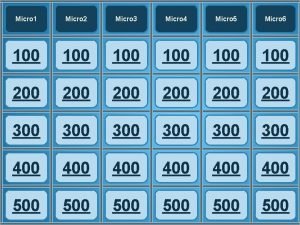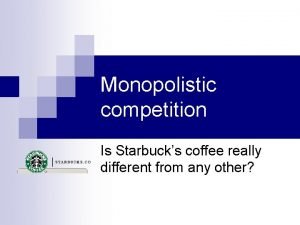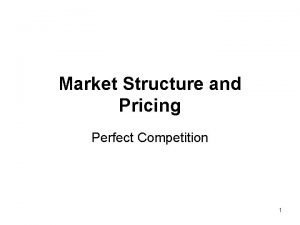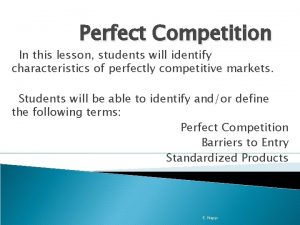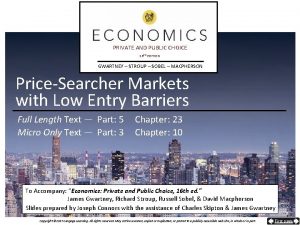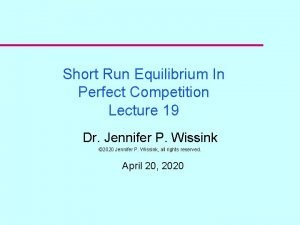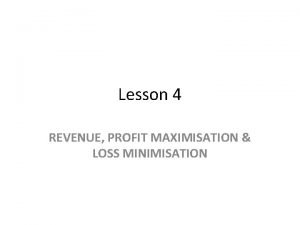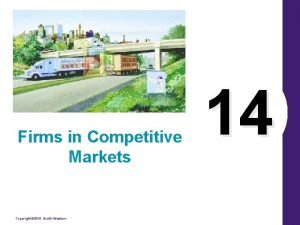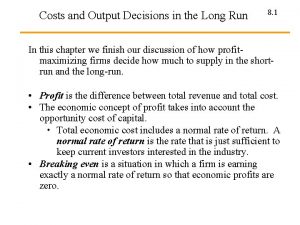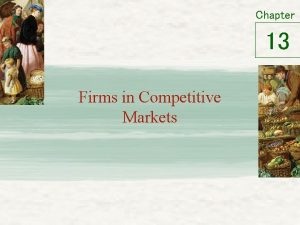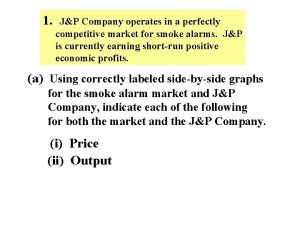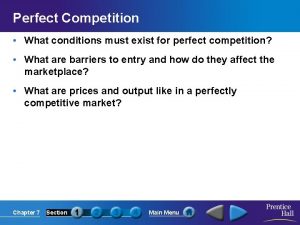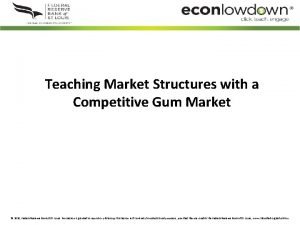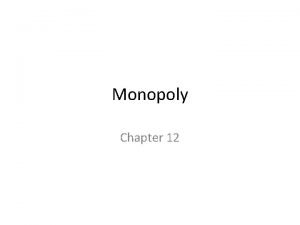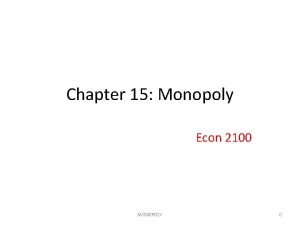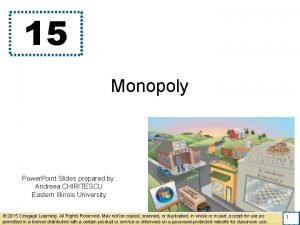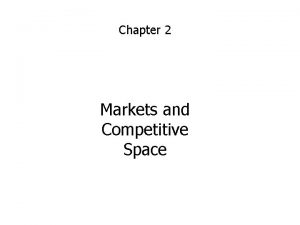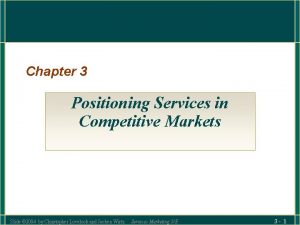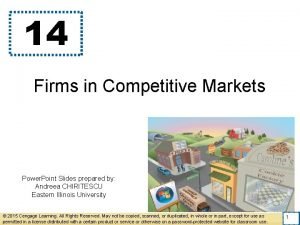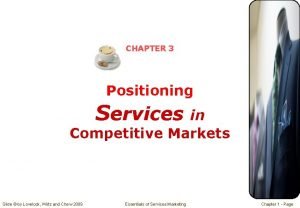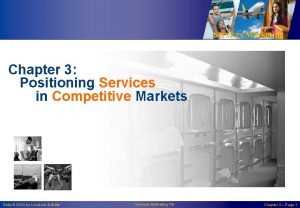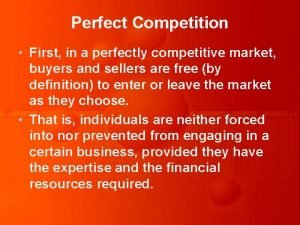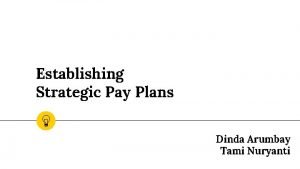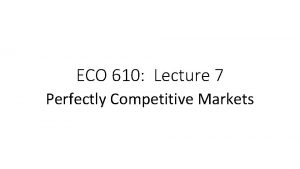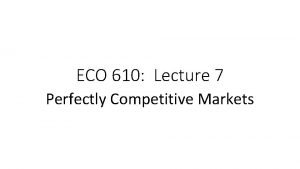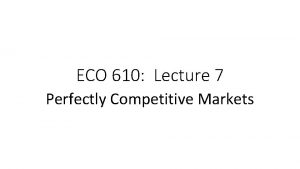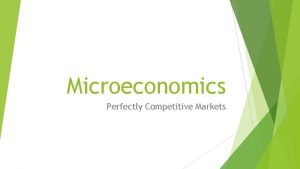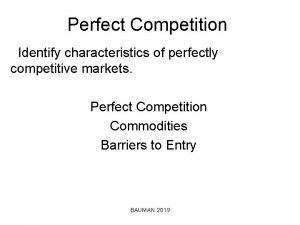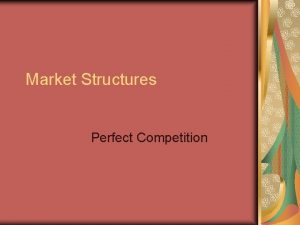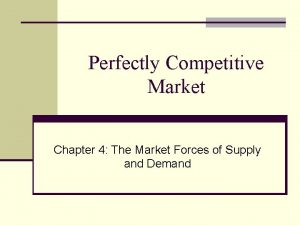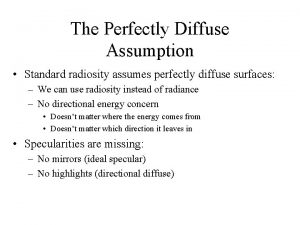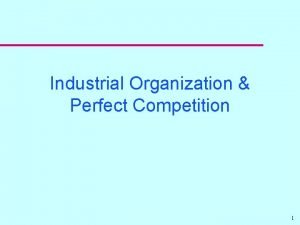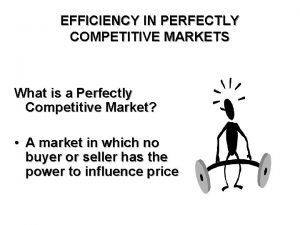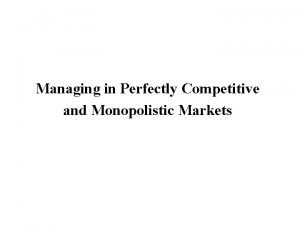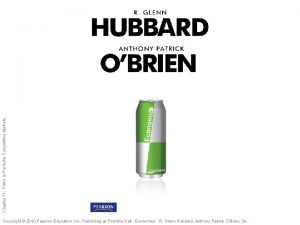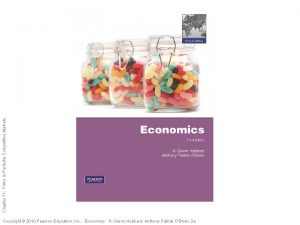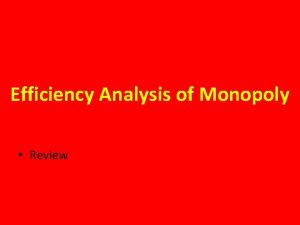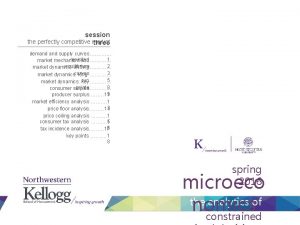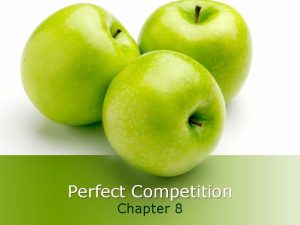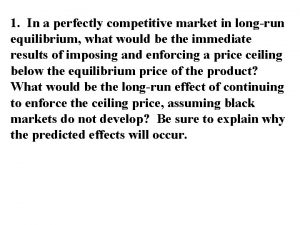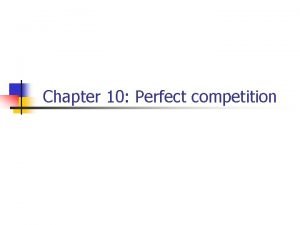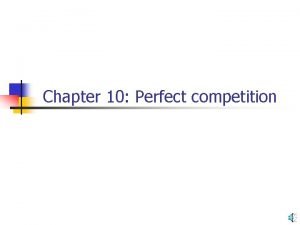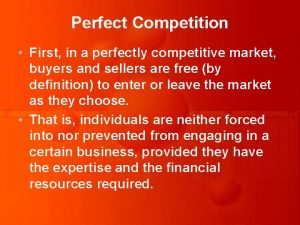Perfectly Competitive Markets n Market Characteristics 1 Price































- Slides: 31

Perfectly Competitive Markets n Market Characteristics 1) Price taking: the individual firm sells a very small share of total market output and so cannot influence market price. The individual consumer buys too small a share of output to have any impact on the price. 2) Product homogeneity: the products of all firms are perfect substitutes. 3) Free entry and exit: Buyers can easily switch from one supplier to another. Suppliers can easily enter or exit a market. Chapter 8 1

Profit Maximization n Do firms maximize profits? l Possibility of other objectives u Revenue maximization u Dividend maximization u Short-run profit maximization l Implications of non-profit objective u Over the long-run investors would not support the company u Without profits, survival unlikely Chapter 8 2

Marginal Revenue, Marginal Cost and π Maximization n Determining the profit maximizing level of output l Profit ( l Total Revenue (R) = Pq l Total Cost (C) = Cq l Therefore: Chapter 8 ) = Total Revenue - Total Cost 3

Profit Maximization in the Short Run Total Revenue Cost, Revenue, Profit ($s per year) R(q) Slope of R(q) = MR 0 Output (units per year) Chapter 8 4

Profit Maximization in the Short Run C(q) Cost, Revenue, Profit $ (per year) Total Cost Slope of C(q) = MC Why is cost positive when q is zero? 0 Output (units per year) Chapter 8 5

Marginal Revenue, Marginal Cost and π Maximization n Comparing R(q) and C(q) l l Output levels: 0 - q 0: u C(q)> R(q): negative profit u FC + VC > R(q) u MR > MC Cost, Revenue, Profit ($s per year) C(q) R(q) A Output levels: q 0 - q* u R(q)> C(q) u MR > MC: higher profit at higher output. Profit is increasing B 0 q* Output (units per year) Chapter 8 6

Marginal Revenue, Marginal Cost and π Maximization n Comparing R(q) and C(q) l Output level: q* u R(q)= C(q) u MR = MC u Profit is maximized Cost, Revenue, Profit $ (per year) C(q) R(q) A B 0 q* Output (units per year) Chapter 8 7

Demand MR Faced by a Competitive Firm Price $ per bushel Firm $4 d Industry $4 D 100 Chapter 8 200 Output (bushels) 100 Output (millions of bushels) 8

Marginal Revenue, Marginal Cost and π Maximization n The competitive firm’s demand u u u Individual firm sells all units for $4 regardless of their level of output. If the firm tries to raise price, sales are zero. If the firm tries to lower price, he cannot increase sales u P = D = MR = AR u Profit Maximization: MC(q) = MR = P Chapter 8 9

A Competitive Firm making a Positive Profit: SR MC Price 60 ($ per unit) 50 40 Lost profit for q 1 < q * A D Lost profit for q 2 > q * ATC C B 30 AVC At q*: MR = MC and P > ATC q 1 : MR > MC and q 2: MC > MR 20 and q 0: MC = MR but MC falling 10 0 Chapter 8 AR=MR=P 1 q 0 2 3 4 5 6 7 q 1 8 q* 9 q 2 10 11 Output 10

A Competitive Firm Incurring Losses: SR MC Price ($ per unit) C D At q*: MR = MC and P < ATC Losses = (P- AC) q* or ABCD F B A P = MR AVC E q* Chapter 8 ATC Would this producer continue to produce with a loss? Output 11

Choosing Output in the Short Run n Summary of Production Decisions l Profit l If is maximized when MC = MR P > ATC the firm is making profits. l If AVC < P < ATC the firm should produce at a loss. l If P < AVC < ATC the firm should -down. Chapter 8 shut 12

A Competitive Firm’s Short-Run Supply Curve Price ($ per unit) The firm chooses the output level where MR = MC, as long as the firm is able to cover its variable cost of production. MC P 2 ATC P 1 AVC What happens if P < AVC? P = AVC q 1 Chapter 8 q 2 Output 13

A Competitive Firm’s Short-Run Supply Curve Price ($ per unit) S = MC above AVC MC P 2 ATC P 1 AVC P = AVC Shut-down q 1 Chapter 8 q 2 Output 14

The Response of a Firm to a Change in Input Price ($ per unit) MC 2 Savings to the firm from reducing output Input cost increases and MC shifts to MC 2 and q falls to q 2. MC 1 $5 q 2 Chapter 8 q 1 Output 15

Industry Supply in the Short Run MC 1 MC 2 $ per unit MC 3 S The short-run industry supply curve is the horizontal summation of the supply curves of the firms. P 3 P 2 P 1 0 Chapter 8 Question: If increasing output raises input costs, what impact would it have on market supply? 2 4 5 7 8 10 15 Quantity 21 16

The Short-Run Market Supply Curve n Elasticity of Market Supply n Perfectly inelastic short-run supply arises when the industry’s plant and equipment are so fully utilized that new plants must be built to achieve greater output. n Perfectly elastic short-run supply arises when marginal costs are constant. Chapter 8 17

Producer Surplus for a Firm Price ($ per unit of output) At q* MC = MR. Between 0 and q , MR > MC for all units. Producer Surplus MC AVC B A D 0 Chapter 8 P C q* Alternatively, VC is the sum of MC or ODCq*. R is P x q* or OABq*. Producer surplus = R - VC or ABCD. Output 18

The Short-Run Market Supply Curve n Producer Surplus in the Short-Run Chapter 8 19

Producer Surplus for a Market Price ($ per unit of output) S Market producer surplus is the difference between P* and S from 0 to Q*. P* Producer Surplus D Q* Chapter 8 Output 20

Output Choice in the Long Run Price ($ per unit of output) In the long run, the plant size will be increased and output increased to q 3. Long-run profit, EFGD > short run profit ABCD. LMC LAC SMC D $40 SAC A C G E B P = MR F $30 In the short run, the firm is faced with fixed inputs. P = $40 > ATC. Profit is equal to ABCD. q 1 Chapter 8 q 2 q 3 Output 21

Output Choice in the Long Run Price ($ per unit of output) Question: Is the producer making a profit after increased output lowers the price to $30? LMC LAC SMC D $40 SAC A C G E B P = MR F $30 q 1 Chapter 8 q 2 q 3 Output 22

Choosing Output in the Long Run Long-Run Competitive Equilibrium n Zero-Profit l If R > w. L + r. K, economic profits are positive l If R = w. L + r. K, zero economic profits, but the firm is earning a normal rate of return; indicating the industry is competitive l If R < w. L + r. K, consider going out of business Chapter 8 23

Long-Run Competitive Equilibrium • Profit attracts firms • Supply increases until profit = 0 $ per unit of output Firm Industry S 1 LMC $40 LAC $30 P 1 S 2 P 2 D q 2 Chapter 8 Output Q 1 Q 2 Output 24

Choosing Output in the Long Run n Long-Run Competitive Equilibrium 1) MC = MR 2) P = LAC u No incentive to leave or enter u Profit = 0 3) Equilibrium Market Price Chapter 8 25

Choosing Output in the Long Run n Questions 1) Explain the market adjustment when P < LAC and firms have identical costs. 2) Explain the market adjustment when firms have different costs. 3) What is the opportunity cost of land? Chapter 8 26

Choosing Output in the Long Run n Economic Rent = the difference between what firms are willing to pay for an input minus the minimum amount necessary to obtain it. n An Example: Two firms, A & B, both own their land l A is located on a river which lowers A’s shipping cost by $10, 000 compared to B. The demand for A’s river location will increase the price of A’s land to $10, 000 l Economic rent = $10, 000 u l $10, 000 - zero cost for the land Economic rent increases; Economic profit of A = 0 Chapter 8 27

The Industry’s Long-Run Supply Curve n The shape of the long-run supply curve depends on the extent to which changes in industry output affect the prices the firms must pay for inputs. n To determine long-run supply, we assume: l All firms have access to the available production technology. l Output is increased by using more inputs, not by invention. l The market for inputs does not change with expansions and contractions of the industry. Chapter 8 28

LR Supply in a Constant-Cost Industry $ per unit of output Economic profits attract new firms. Supply increases to S 2 and the market returns to long-run equilibrium. MC AC $ per unit of output P 2 Q 1 increase to Q 2. Long-run supply = SL = LRAC. Change in output has no impact on input cost. S 1 S 2 C P 2 A P 1 B SL P 1 D 1 q 2 Chapter 8 Output Q 1 Q 2 D 2 Output 29

LR Supply in an Increasing-Cost Industry $ per unit of output SMC 2 SMC 1 LAC 2 LAC 1 P 2 $ per unit of output Due to the increase in input prices, long-run equilibrium occurs at a higher price. S 1 S 2 P 3 P 1 P 1 B A D 1 q 1 Chapter 8 q 2 Output SL Q 1 Q 2 Q 3 D 1 Output 30

LR Supply in a Decreasing-Cost Industry $ per unit of output Due to the decrease in input prices, long-run equilibrium occurs at a lower price. $ per unit of output SMC 1 S 2 SMC 2 LAC 1 P 2 LAC 2 P 1 P 3 A B SL D 1 q 1 Chapter 8 q 2 Output Q 1 Q 2 Q 3 D 2 Output 31
 A farmer produces peppers in a perfectly competitive market
A farmer produces peppers in a perfectly competitive market Perfect competition examples
Perfect competition examples Coffee industry monopolistic competition
Coffee industry monopolistic competition Perfectly competitive market example
Perfectly competitive market example Is milk a perfectly competitive market
Is milk a perfectly competitive market The two least common competitive structures are
The two least common competitive structures are In a competitive price-searcher market, the firms will
In a competitive price-searcher market, the firms will Short run supply curve for a perfectly competitive firm
Short run supply curve for a perfectly competitive firm Perfectly competitive firm profit maximization
Perfectly competitive firm profit maximization Short run supply curve for a perfectly competitive firm
Short run supply curve for a perfectly competitive firm Lrac curve
Lrac curve Long run market supply curve
Long run market supply curve J p company operates in a perfectly competitive
J p company operates in a perfectly competitive For an industry to be perfectly competitive what must exist
For an industry to be perfectly competitive what must exist Upang mapatatag ang presyo sa pamilihan ipinapatupad ang
Upang mapatatag ang presyo sa pamilihan ipinapatupad ang Teaching market structures with a competitive gum market
Teaching market structures with a competitive gum market Theory of monopoly
Theory of monopoly Perfectly price discriminating monopoly
Perfectly price discriminating monopoly Perfectly price discriminating monopoly
Perfectly price discriminating monopoly Perfectly price discriminating monopoly
Perfectly price discriminating monopoly Market and competitive space
Market and competitive space Market positioning services
Market positioning services Firms in competitive markets chapter 14 ppt
Firms in competitive markets chapter 14 ppt Positioning services in competitive markets
Positioning services in competitive markets Positioning services in competitive markets
Positioning services in competitive markets Therapeutic index
Therapeutic index Market commonality and resource similarity examples
Market commonality and resource similarity examples Market leader challenger follower nicher
Market leader challenger follower nicher Steps in market segmentation
Steps in market segmentation Pure competitive market
Pure competitive market What is competitive pay
What is competitive pay Establishing strategic pay plans
Establishing strategic pay plans
